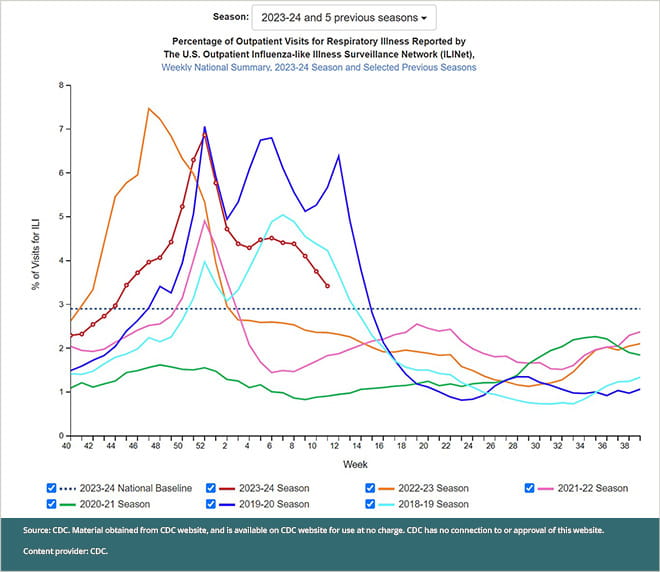Flu cases in the United States hit a high in December. Can we say the flu season is over yet?
With spring now here, you might wonder if the flu season is over…and yet you might still see or hear about people coming down with the flu. In mid-February, famed golfer Tiger Woods made headlines when he withdrew from an invitational golf tournament due to illness, which Woods later confirmed was influenza.
Prior to the COVID-19 pandemic, flu cases in the United States usually began to rise in October, peaked sometime between December and February, and then declined, with the season ending in April (and sometimes in May). But in recent flu seasons since the start of the pandemic, flu activity hasn’t always followed expected patterns, so the timing and duration of the flu season has been less predictable.
So where do we stand in terms of flu cases and flu activity across the United States? Do we have an idea when flu season will be over this year?
Flu cases have declined but remain elevated
In short, flu activity generally seems to be declining. As of March 16, hospitalizations due to the flu have been decreasing after a reaching a peak in late December, according to the Centers for Disease Control and Prevention (CDC). (The CDC also says hospitalizations for COVID and respiratory syncytial virus have also decreased.)
This looks like good news, but it may be too early to call flu season over just yet.
For one thing, the numbers of people who visited outpatient care centers because of flu-like illness did not continue to decrease between the weeks ending on Saturday, March 9, and Saturday, March 16; however, they remained above the national baseline of 2.9%. (Public health reporting provides data for each week of the year, with each week beginning on a Sunday and ending on the following Saturday).

When flu season begins and ends also depends on where you live. Reviewing flu activity in different regions can provide a useful perspective on how the flu is affecting the country.
The CDC’s National Center for Chronic Disease Prevention and Health Promotion divides the United States (including Washington D.C.) into 10 regions, made up of 4 to 7 states. Looking at data from these 10 regions, we can see that flu activity varied greatly across the country between the weeks ending on March 9 and March 16.
Some states and areas--including Arkansas, Iowa, Kansas, Massachusetts, Michigan, Nebraska, New Jersey, New York City, North Dakota, Ohio, and Oklahoma, as well as the District of Columbia and New York City--reported high or very high levels of influenza-like illness activity. However, looking at the 10 regions, all 10 reported that outpatient visits for flu-like illness had either decreased or stayed about the same as the week before.
Where does your state fall in this list?
Regions reporting a similar number of outpatient visits due to flu-like illness vs. the previous week
- Region 8: Colorado, Montana, North Dakota, South Dakota, Utah, and Wyoming
- Region 9: Arizona, California, Hawaii, and Nevada
- Region 10: Alaska, Idaho, Oregon, and Washington
Regions reporting a lower number of outpatient visits due to flu-like illness vs. the previous week
- Region 1: Connecticut, Maine, Massachusetts, New Hampshire, Rhode Island, Vermont
- Region 2: New Jersey, New York, Puerto Rico, and the U.S. Virgin Islands
- Region 3: Delaware, District of Columbia, Maryland, Pennsylvania, Virginia, and West Virginia
- Region 4: Alabama, Florida, Georgia, Kentucky, Mississippi, North Carolina, South Carolina, and Tennessee
- Region 5: Illinois, Indiana, Michigan, Minnesota, Ohio, and Wisconsin
- Region 6: Arkansas, Louisiana, New Mexico, Oklahoma, and Texas
- Region 7: Iowa, Kansas, Missouri, and Nebraska
We may be nearing the end of the flu season soon. But because flu activity remains above the national baseline of 2.9% that indicates we are in flu season, with new cases occurring across the nation.
With flu cases and flu activity shifting, should you get a flu shot?
While some may underestimate the effects that flu can have, it can cause severe illness, resulting in hospitalization or even death. Tiger Woods was reported to have a fever and felt dizziness when starting to play at the invitational before he withdrew; according to his manager, he was administered intravenous (IV) fluids for dehydration. Most people with the flu get better on their own, without needing medical treatment. However, certain groups of people are at higher risk of developing serious complications due to the flu, such as people with asthma, diabetes or heart disease.
The best way to reduce the risk of getting the flu and its potentially serious complications is to get a flu vaccine. Flu vaccines are recommended as long as the flu remains in circulation in your community—if you haven’t gotten yours yet, talk to your doctor about flu activity where you live and whether a flu vaccine might be right for you.
Find a flu shot before the end of the 2023-2024 flu season

